Melbourne Grammar School
| Melbourne Grammar School | |
|---|---|
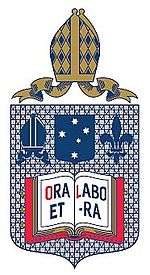 | |
| Location | |
|
South Yarra & Caulfield, Victoria Australia | |
| Coordinates | 37°50′2″S 144°58′34″E / 37.83389°S 144.97611°ECoordinates: 37°50′2″S 144°58′34″E / 37.83389°S 144.97611°E |
| Information | |
| Type | Independent, Co-educational (Primary), Single-sex (Secondary), Day and Boarding |
| Motto |
Latin: Ora et Labora ("Pray and Work")[1] |
| Denomination | Anglican[2] |
| Established | 1849 (on present site since 1858[2] - the celebrated date of foundation) |
| Founder | The Rt Rev. Charles Perry, 1st Anglican Bishop of Melbourne |
| Chairman of Governors | Michael E Bartlett |
| Headmaster | Roy Kelley |
| Chaplain | The Rev. Hans Christiansen |
| Enrolment | 1,782 (P–12) |
| Colour(s) | Dark Blue |
| Website | www.mgs.vic.edu.au |
Melbourne Grammar School is an independent, Anglican, day and boarding school predominantly for boys, located in South Yarra and Caulfield, suburbs of Melbourne, Victoria, Australia.
Founded on 7 April 1858 as the Melbourne Church of England Grammar School, the school has a non-selective enrolment policy and currently caters for approximately 1,800 students from Prep to Year 12, including 120 boarders from Years 7 to 12.[3]
Melbourne Grammar is affiliated with the Headmasters' and Headmistresses' Conference,[4] the Association of Heads of Independent Schools of Australia (AHISA),[5] the Independent Primary School Heads of Australia (IPSHA),[6] the Australian Boarding Schools' Association (ABSA),[3] the Association of Independent Schools of Victoria (AISV),[2] and is a founding member of the historic Associated Public Schools of Victoria (APS). The School is also a member of the G20 Schools Group, and officially a partner school with Waseda University in Japan at the University-level.[7]
History

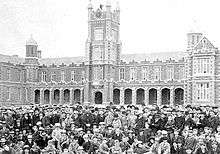
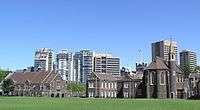
The origins of Melbourne Grammar School (colloquially known as Grammar) can be traced back to 1849, with the establishment of an experimental grammar school at St Peter's Eastern Hill, East Melbourne. This school had been established by Melbourne's first Church of England Bishop, Charles Perry, who founded the Diocese of Melbourne, and had been opened to meet the growing educational needs of the young colony.[8] In 1853, Bishop Perry commenced planning for the diocesan experimental school to become permanent, although on a larger site and not under his direct management, and so he set up a committee of eminent men to consider the task. The school however did not thrive and was suspended at the end of 1854.[9]
The first Board of Governors was elected in 1854 to take over from the committee, and it set about drawing up a Constitution, finding a Headmaster and a new site. Locations considered included Carlton, Prahran and St Kilda.[9]
Perry's dream of building a permanent, centrally located grammar school, based on the principles of the great English public schools, was realised in 1855, with a grant from the Governor Charles Hotham of 15 acres (61,000 m2) on St Kilda Road. This is the inner South Yarra land now occupied by Senior School and Wadhurst, next to the Royal Botanic Gardens and a short walk from the central city. At the time it was considered relatively isolated and remote. The Governors chose architects Charles Webb and Thomas Taylor, well known Melbourne contractors George Cornwell and Co. undertook the construction, and Bishop Perry laid the School's foundation stone on 30 July 1856.[9]
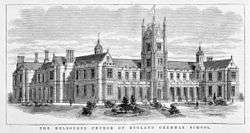
The Melbourne Church of England Grammar School was finally opened on 7 April 1858 with 77 pupils, and with John E. Bromby as the first Headmaster. Enrolments grew to 136 during the first year, with four students being the sons of Bromby, and about one quarter of them boarders.[9]
The school's first forty years proved to be a struggle, exacerbated in the 1890s by economic depression, financial concerns and changes of Headmaster. Senior School enrolments fell from 272 in 1889 to 117 in 1894 prompting a group of former students to do something "to save the old School". They formed The Old Melburnians Society in 1895, "to be the means of bringing together many former schoolmates, reviving pleasant recollections, and at the same time benefiting the life of the School as it is today".[9][10][11]
Two significant developments of the late nineteenth century were, firstly, the recognition that with a limited site, one storey buildings were not a wise use of space. A move began, continued now, of adding second stories or replacing buildings with two- or three-level structures. The second was the dedication of the Chapel of St Peter in 1893, the first school chapel in the colony of Victoria.[9]
The beginning of the new century saw the School's future assured, with enrolments increasing and the Jubilee celebrated in 1908. Hundreds of former students enlisted in the Great War of 1914–1918, as they had in the South African War, and more than 200 did not return.[9]
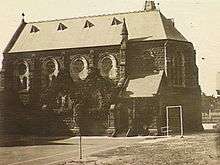
The 1920s were a relatively stable time for the School, experiencing high academic and sporting results. The 1930s however were an unsettling time. The Great Depression put pressure on members of the Grammar community, while administrative instability affected the whole school. Between 1935 and 1938 the School had three Headmasters and two Acting Headmasters, and the outbreak of war the following year meant building plans were put on hold. Some 3,500 Old Boys enlisted in the services, and school buildings were commandeered by Australian and American forces with some students dispatched to the country and others doubled up in crowded quarters.[9]
By the 1950s it became clear that the School was seriously lacking adequate space, with expansions, extensions and renovations mostly crammed into Bromby's original 15 acres (61,000 m2). The School subsequently embarked upon a building program which it was thought could take 30 years to complete, with the Senior School, Wadhurst and Grimwade campuses all receiving attention. The Centenary Building Campaign of 1958 began this expansion. Another solution to this problem since this time has been the steady acquisition of neighbouring properties.[9]
In 1986 the Governors decided on a staged restructure of the School. Until then, Wadhurst, established as a preparatory school in 1886 and Grimwade House, opened in 1918, had operated as two parallel feeder schools taking students through to Year 8. Grimwade's boarding house had closed in the mid-1970s, leading to debate on the best use of the newly available space. It was decided to introduce girls at primary levels at Grimwade House, and today Grimwade House caters for girls and boys up to Year 6 and Wadhurst for boys in Years 7 and 8.[9]
The 1980s and 1990s were times of further growth, with the outdoor program expanded with three permanent campsites at Breakfast Creek near Licola, Woodend and Banksia Peninsula on the Gippsland Lakes. On 7 April 2008, as part of the celebrations of Melbourne Grammar's sesquicentenary, the School officially opened the multimillion-dollar Nigel Peck Centre for Learning and Leadership on the Domain Road boundary, an event which was attended by the Premier of Victoria, John Brumby, who is also an Old Melburnian.[9]
Headmasters
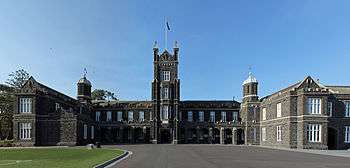
| Period | Details |
|---|---|
| 1858 – 1875 | John Edward Bromby |
| 1875 – 1883 | Edward Ellis Morris |
| 1883 – 1885 | Alexander Pyne |
| 1885 – 1893 | Ambrose John Wilson |
| 1894 – 1898 | Frederic Sergeant |
| 1899 – 1914 | George Ernest Blanch |
| 1915 – 1936 | Richard Penrose Franklin |
| 1937 – 1938 | David Stacey Colman |
| 1938 – 1949 | Joseph Richard Sutcliffe |
| 1950 – 1970 | Sir Brian William Hone |
| 1970 – 1987 | Nigel Arthur Holloway Creese |
| 1988 – 1994 | Antony James de Villiers Hill |
| 1995 – 2009 | Andrew Paul Sheahan |
| 2009 – | Roy Kelley |
Campuses
Melbourne Grammar School features seven campuses, three used for everyday schooling, one for sporting activities, and three for the School's outdoor education program:
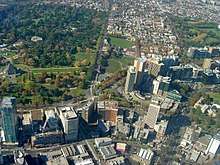
- Grimwade House – Caulfield (Co-ed; Prep to Year 6)
- Wadhurst – South Yarra (All boys; Years 7–8)
- Senior School – South Yarra (All boys; Years 9–12)
- Edwin Flack Park – Port Melbourne (Sporting complex)
- Camp Dowd – Gippsland Lakes (Camp; Year 8)
- Robert Knox Camp – Woodend (Camp; Years 5–7)
- L.G.Robertson Camp – Breakfast Creek, Licola (Camp; Years 9–12)
House system[12]
In 1914, Headmaster G. E. Blanch introduced a formal house structure to further encourage interest in sport and promote physical development. Six houses were originally established. In addition to School House (the traditional English name given to the boarding house), names of the others houses commented the first two headmasters of Melbourne Grammar School (Bromby, Morris), two benefactors (Rusden, Witherby), and two brilliant all-rounder Old Melburnians (Jack and Hugh Ross). A room was assigned to each house where they could gather for meetings and socialise.
Initially, students were sorted into houses based on geographic distribution. Thus, boys from Toorak were put into Bromby House, while those from South Yarra and west of the river entered into Rusden House. Students from Malvern and Glen Iris joined Morris House, those from Brighton and other suburbs around the bay become members of Ross House, and Witherby House welcomed boys from Canterbury, Camberwell and other suburbs around the perimeter of Essendon.
The houses competed for the house championship and the prestige of being named "Cock House". They competed against each other in cricket, rowing, football, boxing (until 1950), running, shooting (until 1937), tennis and swimming.
Cock House Cup
From the earliest days, competition between the houses was fierce. The prize in question was the Cock House Cup. A points system was put in place, and houses gathered points in a range of sports in their quest to be recognised as the reigning house.
First presented in 1916 by Sir Ronald Munro Ferguson, the sixth Governor General of Australia, the Cock House Cup was intended to stimulate interest in house games and to build the sense of the houses as individual entities.
School House was the most successful competitor during the competition, securing the title twenty-six times between 1914 and 1956. Following each victory, the cup was passed around, according to School House tradition, so that each member of the house could drink from it.
Hone reforms
Upon becoming headmaster in 1951, Brian Hone initiated significant change in the purpose of the houses, shifting the focus from sporting prowess to pastoral care, house unity and the growth of the character of the students. The Cock House Cup was thought to be impeding this vision, so it ceased to be awarded.
School House, as the original boarding house was perceived to be the backbone of life at the school. The 1920s, 1930s and 1940s were the era of the 'Long Dorm', which saw justice meted out by the House Captain and Prefects. The North dormitory 'terrorised the school', however, following the disruption to the school during the Second World War a shift in power occurred and the day boys 'got out from under'.[13] Following the war, it was only the boarders who were still 'terrorised', by this time it was by the East dormitory.[13] It was Hone who gave the coup de grâce to the worst School House rituals that remained by the end of his first year.
Expansion of the house system
The house system continued to evolve over the next six decades, with the establishment of a further six houses. Perry House was founded in 1940 and established as the school's second boarding house in 1952. Bruce House was established in the same year, as a new house for day students. The next two houses were Deakin House and Miller House, both established in 1961, with Hone House following in 1979. The most recent edition was Creese House, established in 2005.
Curriculum
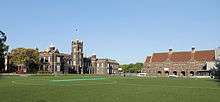
Melbourne Grammar offers its Years 11 and 12 students the Victorian Certificate of Education (VCE), the main assessment program which ranks the students in the state.
In 2004, six Melbourne Grammar students achieved the maximum possible Equivalent National Tertiary Entrance Rank (ENTER) of 99.95; only 32 students in Victoria achieved this ENTER. In 2005, five Melbourne Grammar students achieved this same ENTER of 99.95.[14] In 2006, two Melbourne Grammar students achieved the maximum ENTER of 99.95, and three Melbourne Grammar students achieved an ENTER of 99.90. In 2007, three Melbourne Grammar students achieved the maximum ENTER of 99.95; again, only 32 students in Victoria achieved this ENTER. In 2008, five Melbourne Grammar students achieved the maximum ENTER of 99.95.[15] This tradition was continued in 2009, when a record seven students achieved the maximum ENTER of 99.95. The school also recorded its best average score on record in 2009, with the median ENTER being 93.95. In 2010, three students achieved the highest possible ATAR score of 99.95 with median 91.5. In 2011, Melbourne Grammar School's VCE students have achieved a commendable 89.8 median ATAR score, and another seven students achieved the maximum possible ATAR of 99.95. Most recently in 2016, one student was awarded the maximum ATAR of 99.95.
Co-curriculum
Debating
Melbourne Grammar has held inter-grammar school British Parliamentary Debating competitions involving Scotch College, Sydney Grammar, and Melbourne Grammar. Also, Melbourne Grammar enters students into the Debaters Association of Victoria's (DAV) Debating Competition in the Toorak region. In 2016, Melbourne Grammar won both the B Grade and D Grade competitions, and in 2017, won the D Grade competition for the second year in a row. [16]
Music
Melbourne Grammar is noted for its Orchestra, the Melbourne Grammar School Symphony Orchestra (MGSSO), which tours internationally in December every year. In 2005 the Orchestra toured Malaysia and Singapore and in 2006 travelled to China, performing in Shanghai, Hong Kong, and Guangzhou. December 2007 saw the orchestra touring Dubai, Zagreb, Ljubljana and Venice, while in December 2008 the orchestra once again returned to Malaysia for Martin Rutherford's final orchestra tour. In 2009 Mark Drummond took over the orchestra and in 2010 the orchestra toured Japan, performing in Osaka, Tokyo (at the Okuma Auditorium which is located at Waseda University) and Gamagori. The MGSSO toured France and Belgium in 2012, then the USA in 2014, and Germany, Austria and the Czech Republic in December 2016. In 2018, it is scheduled to tour the UK, playing in London, Edinburgh and Glasgow. The orchestra is usually made up of around 100 students, the vast majority attendants of the school. All campuses have their own choirs, concert bands and string orchestras. The Chapel Choir is the oldest of any Victorian private school and consists of about 40 select members. It sings at the weekly Eucharists along with occasional concerts with the like of the Australian Brandenburg Orchestra.
The MGSSO has accompanied international soloists such as Ronald Farren-Price, Leslie Howard and Neville Taweel, and has premiered works by Australian and British composers.[17]
Sport
Cordner-Eggleston Cup
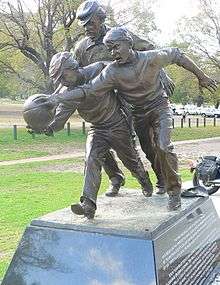
The Cordner-Eggleston Cup is competed for each year by the first football teams of Melbourne Grammar School and the Scotch College and has been run since 1858, making it the longest running school football fixture in the world.
The Rose and Thistle Cup
The Rose and Thistle Cup traditionally is the match of the Melbourne Grammar Soccer 1st XI and the Scotch College 1st XI. Inaugurated in 2008, it represents the Rose of England - Melbourne Grammar and the Thistle of Scotland- Scotch College. The cup has an annual theme of 'Two Traditions, One Spirit.'
Rowing
Melbourne Grammar has a proud rowing record, having claimed the Head of the River 28 times, the most recent being in 2016. In 2009 the school had an exceptional 1st VIII who broke the Head of the River record. They also won the National Schoolboy 8+ in record time. They rowed a very credible race to win the schoolboy title over the Shore School in 5:49.
Athletics
In recent years, Melbourne Grammar School has become a force in Athletics, winning the APS premiership for the first time in 48 years in 2010. For most of the 90s and early 2000s, the school struggled in athletics. The turnaround started in 2004, and over the past seven years, the School has won the Victorian track relay titles - a measure of the quality of the track program.
Soccer
The Melbourne Grammar 1st XI Soccer team is yet to win an APS premiership, however, finishing a tightly-contested 3rd in 2014 and subsequently missing out on the premiership cup following a draw against reigning premiers, Brighton Grammar. The strength of Melbourne Grammar soccer is emerging strongly throughout the years and strong performances by the First XI were seen in 2014 and 2015 under the guidance of Jesper Olsen, former Manchester United and Danish International winger. Soccer is currently one of the most played sports at the school.
In recent years, Melbourne Grammar School has produced A-League footballers including Stefan Nigro (Melbourne Victory) who received Man of The Match on debut against Brisbane Roar and Yaren Sozer (Melbourne City FC) who played against EPL giants Manchester City. Furthermore, as of 2016, Old Melburnians have signed for overseas clubs in Spain. Salvatore Sitch won the "MVP" award for the First XI in 2015.
Basketball
Melbourne Grammar is an emerging force in the Victorian APS basketball competition, finishing third in 2012 and 2014. Recent noteworthy players include Dane Pineau (recruited by St Marys College US), 2012 Captain and also Captain of the Australian under-19s national team, Daniel Fisher, who went on to attend American University on a scholarship and Victorian State and BigV men's players Jakob Cornelissen (recruited by University of Hawaii US) and Andrew Panyiotou. MGS basketball is coached by OM Tom Chambers
Volleyball
Melbourne Grammar School's highest placing in the APS Volleyball Competition is third and has forged a rich heritage of boys going on to play at University and State levels.
Theatre
Melbourne Grammar has a strong theatre department, especially within the Senior Campus, which produces four plays each school year. In Term One, the Quad Play, most commonly a Shakespeare play, but on occasion from other notable playwrights, is performed within the school's Quadrangle, and is open to students in years 10 to 12. In 2014, the Quad Play celebrated its 40th anniversary with a production of Antony and Cleopatra, celebrating a notable history of productions including The Crucible, Twelfth Night and Much Ado About Nothing.
The School Play, performed in August, is often the centrepiece of the year's theatrical calendar. These take place in the Memorial Hall, which was refurbished in the early 2000s. Staging is often designed by a contracted individual, with sets constructed jointly by staff and students, often both current and former. These productions alternate between musicals and plays. Notable productions in recent history have included Tim Winton's Cloudstreet, Gilbert and Sullivan's The Pirates of Penzance, Lerner and Loewe's "My Fair Lady", Oscar Wilde's An Ideal Husband, and most recently, Leonard Bernstein's West Side Story. In 2014, Melbourne Grammar School will be performing Peter Shaffer's Amadeus.
The final performance for the year is the Spring Production which is open to Years 9 and 10 students. These plays take place in late Term Four off-campus to free the Memorial Hall for VCE exams. These productions in recent years have provided modern updates to classic stories, including Lord of the Flies', Animal Farm and Sweeney Todd, as well as performing modern plays such as Nick Enright's Spurboard. In 2013, this production will be another modern update, this time being Eugène Ionesco's Rhinoceros.
All of these plays are performed by the students of Melbourne Grammar in conjunction with students from the sister school, Melbourne Girls Grammar School, whose campus is located nearby.
Wadhurst, Melbourne Grammar's middle school, also partakes in an annual production. This is performed either on the Wadhurst Deck or in the Wadhurst Hall. In 2008, to celebrate the school's sesquicentenary, the play Glimpses of the Generations was performed featuring 150 years of the school's history. These productions usually take the form of a classic children's tale such as Pinocchio or A Christmas Carol. In 2013, the Wadhurst Production will take the form of a film, featuring a Melbourne Grammar twist on Alice in Wonderland, produced by students.
Year 8 students also have the opportunity to take part in the Year 8 Project, established in 2012 with a reimagining of A Midsummer Night's Dream. Students from Melbourne Grammar and Melbourne Girls Grammar have the opportunity not only to act in a play but to take part in the development and production of the play. The 2013 production was a surrealist modern update of Alan Ayckbourn's Ernie's Incredible Illucinations.
Crest and motto
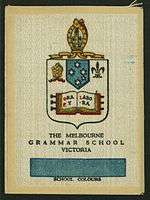
The school motto, Ora et Labora, which may be translated from Latin to "Pray and Work", was chosen by the second headmaster, Edward Morris, in 1875.[1]
An old boy of England's Rugby School, Morris exemplified the way the principles of the English Public School system were adopted in Australia, including that education and religion should go hand in hand, as envisaged by Bishop Perry. The motto clearly reflects this.[1]
The school crest is composed of a number of elements. The Archbishop's mitre placed on top of the crest indicates the school's connection with the Church of England; the mitre in the shield is in memory of Charles Perry, the schools founder; the open book represents either the bible or 'Knowledge like an Open Book', while its large clasps show that the book is not to be opened with ease; the Fleur de Lys (lily) is a symbol of purity; and the Southern Cross is the emblem of Australia, and is also on the Victorian and Australian flag.[1]
Notable alumni
Alumni of Melbourne Grammar School are commonly referred to as Old Melburnians and may elect to join the schools' alumni association, the Old Melburnians' Society (OMS).[18] Some notable Old Melburnians include:
Governor-General
- Richard Casey, Baron Casey of Berwick – 16th Governor-General of Australia
Prime Ministers
- Stanley Bruce, Viscount Bruce of Melbourne – 8th Prime Minister of Australia
- Alfred Deakin – 2nd Prime Minister of Australia
- Malcolm Fraser – 22nd Prime Minister of Australia[19]
State Premiers
- Ted Baillieu – 46th Premier of Victoria
- John Brumby – 45th Premier of Victoria
Victoria Cross recipients
- William Joynt – soldier, Victoria Cross winner
- Bill Newton – airman, Victoria Cross winner
Military and security
- Alfred Brookes – first head of the Australian Secret Intelligence Service
- Samuel Burston – doctor, soldier, horseracing identity
- Adrian Cole-Air Chief Vice Marshall RAAF
- Ernest Gaunt – Royal Navy Admiral
- Guy Gaunt – Royal Navy Admiral and British Conservative Member of Parliament
- Harold Grimwade – soldier
- Sir Vernon Sturdee, Lieutenant-General
- Sir Edmund Herring – soldier and judge
- Cedric Howell – First World War fighter pilot and flying ace
- Frederic Hughes – soldier
- Leslie Morshead – soldier (MGS Staff member)
- Cyril Seelenmeyer — VFL footballer, veterinary surgeon, winner of Military Cross
- Sir Edward Woodward AC OBE QC - judge, Royal Commissioner and former head of ASIO
Law and government
- Sir Keith Aickin – former Justice of the High Court of Australia
- Austin Asche – former Administrator of the Northern Territory
- David B. Ashley – Judge of the Victorian Court of Appeal
- Maurice Blackburn – politician, lawyer and founder of Maurice Blackburn Lawyers
- Julian Burnside QC – barrister
- Sam Calder – politician
- Frank Callaway – former judge, Victorian Court of Appeal
- Vasey Houghton – politician
- Wilfrid Kent Hughes – Rhodes Scholar, politician
- Chris Maxwell – Rhodes Scholar, President of the Victorian Court of Appeal
- Kenneth Marks – former Judge of the Supreme Court of Victoria and Royal Commissioner
- William Moule – politician and cricketer
- William Ormiston – former Judge, Victorian Court of Appeal
- John Thwaites – politician
Media, entertainment, and the arts
- Oscar Asche – actor, director and writer
- John Brack – artist (MGS staff member)
- Robin Casinader - musician
- Andrew Daddo – actor, voice artist, author and television personality
- Jonathan Dawson – screenwriter, director, academic and columnist
- Sir Randal Heymanson - journalist
- Barry Humphries – entertainer
- Barrie Kosky – opera and theatre director
- Nam Le – writer
- Sir William McKie – former Organist and Master of the Choristers at Westminster Abbey
- Rupert Myer AO - Chairman of the Australia Council for the Arts
- Hugo Race - Musician
- Dan Robinson – singer
- Rob Sitch – film director, producer and screenwriter
- Frank Thring – actor
- Mick Turner - musician (Dirty Three) and artist
- Li-Wei Qin - International concert cellist
Sport
- Simon Beaumont – Australian Rules footballer
- Sir Norman Brookes – tennis player
- Dylan Clarke – Australian Rules Footballer
- Ryan Clarke - Australian Rules footballer[20]
- John Conway - Australian Rules footballer and cricketer
- Don Cordner – doctor and Australian Rules footballer
- David Crawshay – 2008 Olympic gold medallist Men's Double Sculls
- Ben Dodwell - dual Olympian rower
- Nathan Drummond – Australian Rules footballer[20]
- Shaun Edwards – Australian Rules footballer[20]
- Xavier Ellis – Australian Rules footballer[20]
- Edwin Flack (Teddy) – 1896 Olympic gold medallist (Australia's First Gold Medal)
- Simon Fraser - Australian Rules footballer and 1912 Olympic rower.
- Hugh Goddard- Australian Rules footballer[20]
- Steven Greene-Australian Rules Footballer
- Tom Hawkins – Australian Rules footballer[20]
- Tom King – Sailor, Olympic Gold Medallist (2000)
- Ed Langdon – Australian Rules footballer[20]
- Tom Langdon - Australian Rules footballer[20]
- Chris Langford – Australian Rules footballer and AFL commissioner
- Ben Long - Australian Rules footballer
- Steven May - Australian Rules footballer[20]
- Zach Merrett - Australian Rules footballer[20]
- Luke Mitchell - Australian Rules footballer
- Derek Mollison — Australian Rules footballer, military officer
- Stefan Nigro – A-League player
- George O'Mullane - Australian Rules footballer and cricketer
- Jackson Paine – Australian Rules footballer[20]
- Fletcher Roberts – Australian Rules footballer[20]
- Matt Thomas – Australian Rules footballer
- Andrew Thompson – Australian Rules footballer
- Athol Tymms – Australian Rules footballer and doctor
- Mike Woods - Australian Rules footballer
Other
- Harry Brookes Allen – pathologist
- Mervyn Austin – Rhodes Scholar, former Headmaster of Newington College and academic
- John F. O. Bilson – academic
- Manning Clark – historian
- Lancelot de Mole – Engineer and inventor of the first tank[21]
- Aubrey Gibson– businessman and philanthropist[22]
- Keith Hancock – Rhodes Scholar, historian
- Charles Kellaway – scientist
- Ainslie Meares - psychiatrist, expert in the medical use of hypnotism
- Godfrey Tanner - academic[23]
See also
Notes
- ^ Who's Who of boys' school rankings: 1. Melbourne Grammar School, 2. Scotch College, Melbourne, 3. Melbourne High School, 4. Geelong Grammar School, 5. Sydney Boys High School, 6. Wesley College, 7. Shore, 8. Fort Street Boys' High, 9. North Sydney Boys High School, 10. Sydney Grammar School
References
- 1 2 3 4 "School Crest and Motto". History. Melbourne Grammar School. Archived from the original on 1 May 2008. Retrieved 2 February 2008.
- 1 2 3 "Melbourne Grammar School". Find a School. Association of Independent Schools of Victoria. 2007. Archived from the original on 6 July 2011. Retrieved 2 February 2008.
- 1 2 "Melbourne Grammar School". Schools - Victoria. Australian Boarding Schools Association. Archived from the original on 17 November 2007. Retrieved 2008-02-02.
- ↑ "International Members". HMC Schools. The Headmasters' and Headmistresses' Conference. Archived from the original on 15 March 2008. Retrieved 2008-03-11.
- ↑ "Victoria". School Directory. Association of Heads of Independent Schools of Australia. 2008. Archived from the original on 7 March 2008. Retrieved 2008-02-02.
- ↑ "JSHAA Victoria Directory of Members". Victoria Branch. Junior School Heads' Association of Australia. 2007. Archived from the original on 13 February 2008. Retrieved 2008-02-02.
- ↑ http://www.waseda.jp/intl-ac/assets/partnerinstitutions_departmental.pdf
- ↑ "History". About Us. Melbourne Grammar School. Retrieved 2008-02-02.
- 1 2 3 4 5 6 7 8 9 10 11 "History of MGS". About Us. Melbourne Grammar School. Archived from the original on 1 May 2008. Retrieved 2 February 2008.
- ↑ At a meeting held at Melbourne Grammar School on 22 April 1895, called to inaugurate an organization for former students that would amalgamate and oversee the activities of various sporting activities, such as the athletics, cricket, gymnastics clubs that were already established for "old boys" as well as any others that might be created in the future (e.g., football). After strong debate, with a number of suggested names, including "Old Church of England Grammar School Boys' Association", being rejected, the meeting (composed of "old boys" from all eras, including the 1860s) decided upon the name "Old Melburnians" for the "old boys" umbrella organization (see: Old Boy, "College Sports: Weekly Jottings", The Australasian, (Saturday, 27 April 1895), p.19.
- ↑ "The Old Melburnians": Inaugural Reunion, The Argus, (Friday, 10 May 1895), p.6.
- ↑ "The Centenary of the Senior School House System: 1914-2014". Booklet. Melbourne Grammar School. 2014.
- 1 2 Eagle, Chester (1986). Play together, dark blue twenty. Melbourne: Trojan Press.
- ↑ Leung, Chee Chee (2005-12-13). "Public school trio make mark on VCE results". National. Melbourne: The Age. Retrieved 2008-03-26.
- ↑ Sheahan, Paul (2007-12-17). "Outstanding VCE results". News. Melbourne Grammar School. Archived from the original on 15 March 2008. Retrieved 2008-03-26.
- ↑ http://www.dav.com.au/news.php?id=news59f7e4dd9a700
- ↑ Martin Rutherford (2006). "Martin Rutherford, Associate Composer, Australian Music Centre". Australian Music Centre. Retrieved 2007-08-14.
- ↑ "Old Melburnians - Alumni". Grammar Community. Melbourne Grammar School. Archived from the original on 24 November 2007. Retrieved 2008-02-02.
- ↑ Burke, Kelly (10 February 2004). "One of the old school". TV & Radio. Melbourne: The Age. Retrieved 2008-02-20.
- 1 2 3 4 5 6 7 8 9 10 11 12 "Old Melburnians in the AFL". Melbourne Grammar School. Retrieved 21 January 2017.
- ↑ Coulthard-Clark, C.D (1981). "De Mole, Lancelot Eldin (1880 - 1950)". Australian Dictionary of Biography. 8 (Online ed.). Melbourne, Vic.: Melbourne University Press. pp. 278–279. Retrieved 2008-03-26.
- ↑ Who's Who in Australia 1971, 'Gibson, Aubrey Hickes Lawson'.
- ↑ http://libguides.newcastle.edu.au/placenames/tannerbar
Further reading
- Challenging Traditions, Weston Bate and Helen Penrose (2002)
- Kiddle, J Beacham, (ed), Liber Melburniensis (1848-1936), Robertson & Mullens Ltd, Melbourne, 1937
- Liber Melburniensis, Centenary edition 1858-1958, revised edition 1915-1995
- Southerner, "The Story of Great Public Schools: Melbourne Grammar: Sporting Record of Famous Melburnians", The Referee, (Wednesday, 21 January 1931), p.13.
External links
- Melbourne Grammar School website
- Encyclopedia of Melbourne article